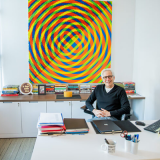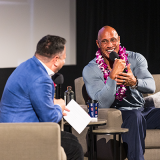TV Is Good 4U: Prof. Brown Interviews Jillian Arnold About Filming in Space
September 26, 2012
Chapman Alumna Jillian Arnold, professor of Cinematography, describes the process of filming in space, which she recently had the opportunity to do as a cinematographer for NASA.
When you become a cinematographer, you have lots of dreams. You might dream of being the DP on one of your favorite books, like Lord of the Rings or Harry Potter. Or maybe you dream of working with a legendary director, like Steven Spielberg. But it might not occur to you to dream about shooting a spacecraft landing on Mars – which is exactly what Professor Jillian Arnold, who studied at Chapman and now teaches cinematography, got to do this summer as part of her other job, working as a cinematographer for NASA and the Jet Propulsion Laboratory in Pasadena, California.
How did you come to work for NASA and JPL?
Almost a year after I completed my Masters at Chapman in Cinematography, I received a call from a recruiting company that saw my work for PBS. I shot several interviews the previous fall with astronauts Neil Armstrong and Barbara Morgan for an event that PBS KOCE was covering. JPL was looking to staff more camera operators for the 2008 Phoenix Mars Landing, which was my first mission. Looking back, I realize how young I was in shooting such a historical event as the Phoenix Mars Landing. I didn’t realize that what I was shooting would be on every major network all over world!
What other events have you covered?
I have covered two Mars landings (Phoenix, Curiosity), four launches at Cape Canaveral (Lunar Reconnaissance Orbiter to the Moon, Juno to Jupiter, Grail to the Moon, Curiosity to Mars), two comet flyby missions (NEXT Stardust, Epoxi Deep Impact), spacecraft testing (Orion Spacecraft for manned missions, Curiosity, Athlete), and the reveal of the Wide Field Planetary Camera, when it came back from Hubble. Most of these projects were shot in 4k High Resolution 3D, and some were live to broadcast.
Also, I was honored to be a part of the Summer of Innovation Event to kick off President Obama’s STEM (Science, Technology, Engineering, Math) outreach program, as well as to shoot interviews and b-roll footage for the documentary, “The Rocketeers,” which aired on PBS.
Those are are the glamorous jobs! I also shoot lectures, presentations, interviews, and document stories on lab for their archives. Regardless, it takes my breath away when I shoot spacecrafts that will see the Moon, Mars, and Jupiter.
Do you just shoot the landings or do you photograph preparation, testing and so forth?
Each project has its own budget and documentation needs, so the time I spend with each mission varies. Some missions have less time consuming needs, like NEXT, or Epoxi where I shot live handheld in the Mission Support Area at JPL for the mission’s broadcast and press briefings. Others like Juno or Grail required travel to Cape Canaveral to shoot the spacecraft roll out from the vehicle assembly building to the launch pad where it took off the following day.
I shot Curiosity more than most projects, because it was assembled locally, in JPL’s facility. My first big field project for JPL was actually Curiosity’s parachute testing several years ago. There, a TV engineer and I developed the 4k stereo shooting system that we have in place now. We then went on to shoot Curiosity’s drop test, the wheel installation, the first and second time they drove her, and several other tests. When I saw the picture of her wheel on Mars for the first time, I had tears in my eyes. It felt like I just shot her yesterday.
Describe how you felt seeing the Mars Rover Curiosity actually landing on the surface of Mars…while you were photographing it.
I was so excited for landing day. I knew in my gut, she was going to land. The Mission Support Area (MSA) had a calmness to it that I wasn’t expecting. Several of the gentlemen on the EDL landing team were playing Sinatra for a few minutes. I knew it would be the most difficult shoot of my life, because you want to celebrate with those around you, but you also have a job to do.
As the time ticked down, each person in the MSA celebrated when their part of the EDL landing was successfully completed. After the infamous “seven minutes of terror” (we didn’t know the spacecraft’s health status until seven minutes after it landed, because of transmission time), the room shook with excitement. I have never seen so many grown men cry in my life! And for the first time in my career, I cried the entire time I shot. I shook with excitement and was mobbed with hugs.
That night, I had the honor of being the eyes to the world for my country. It is still difficult for me to articulate that moment because it was so surreal. My dad called me the next morning and said “I watch the Apollo mission documentaries and I think, ‘someone’s child shot that.’ But last night, my daughter shot Curiosity.”

